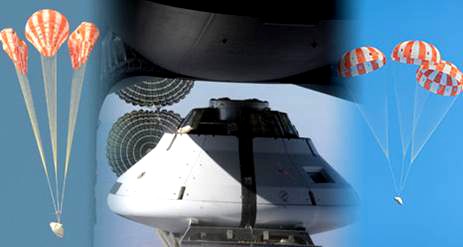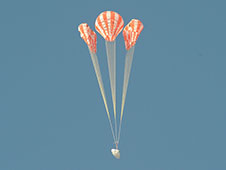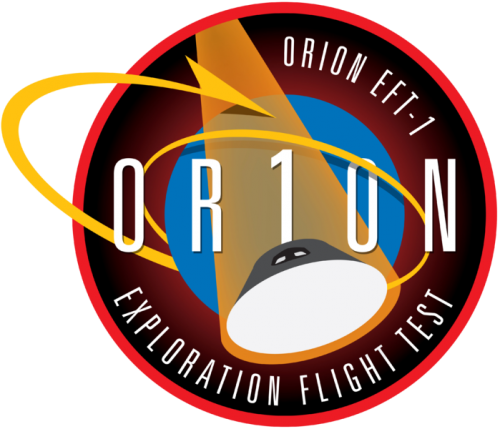
A test article of NASA’s Orion Multi-Purpose Crew Vehicle conducted tests to see how the spacecraft’s parachutes would handle failure scenarios. The tests were conducted in the deserts of Yuma, Ariz., Wednesday, May 2, 2013.
During the test, the Orion mockup traveled at approximately 250 mph when the parachute was deployed. To date, this was the highest rate of speed Orion has experienced during these parachute tests.

“The tests continue to become more challenging, and the parachute system is proving the design’s redundancy and reliability,” said Chris Johnson, NASA’s project manager for the Orion parachute assembly system. “Testing helps us gain confidence and balance risk to ensure the safety of our crew.”
In the failure test, technicians intentionally set one of the three parachutes to not deploy, as well as have one of the three main parachutes skip its first inflation stage after exiting its plane some 25,000 feet above the desert floor.
By testing out how the parachute system will react to failures, engineers can verify the level of reliability of them. The information gleaned from these tests will now be incorporated into the designs of both future iterations of the parachutes as well as the Orion spacecraft itself. It is hoped that other government or commercial spacecraft which use similar systems can benefit from these tests as well.
In a normal deployment, drogue parachutes slow and reorient Orion as the main parachutes inflate in three separate stages to slow the spacecraft on its descent. NASA views this as one of the most difficult tests that the parachutes have been tested under thus far and being crucial for giving the system a human-rating.

“Parachute deployment is inherently chaotic and not easily predictable,” said Orion’s Landing and Recovery System Manager Stu McClung. “Gravity never takes any time off—there’s no timeout. The end result can be very unforgiving. That’s why we test. If we have problems with the system, we want to know about them now.”
Orion’s parachute is described by NASA as being the largest that has been developed for a human-rated spacecraft. All total, the parachutes canopies can cover an entire football field. As it currently stands, these parachutes will be used to slow Orion down as it descends to the Pacific Ocean (where the capsule will splash down when it returns from missions).
The next parachute test planned for Orion is currently scheduled to take place this July. This time, the capsule will be dropped from a height of 35,000 feet. This will be the lead up to the first test flight of the spacecraft at the end of next year.
NASA currently plans to launch a flight test article of the Orion spacecraft atop a United Launch Alliance Delta IV Heavy from Cape Canaveral Air Force Station’s Space Launch Complex 37 in September of next year. The spacecraft will travel unmanned out to a distance of approximately 3,600 miles. When it returns to Earth, it is estimated that it will reenter the Earth’s atmosphere at a speed of 20,000 mph. The estimated speed at which the parachutes will open during the EFT-1 mission is about 340 mph.
Want to keep up-to-date with all things space? Be sure to “Like” AmericaSpace on Facebook and follow us on Twitter:@AmericaSpace




One Comment
One Ping
Pingback:United States and North American News | David Reneke | Space and Astronomy News